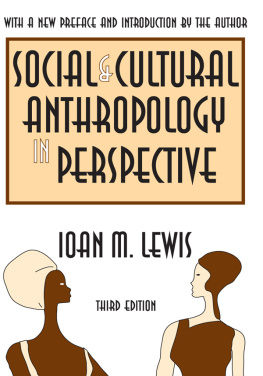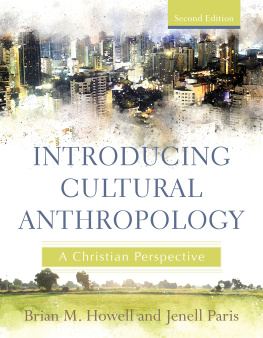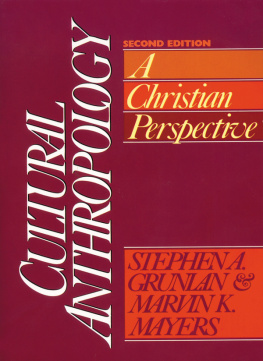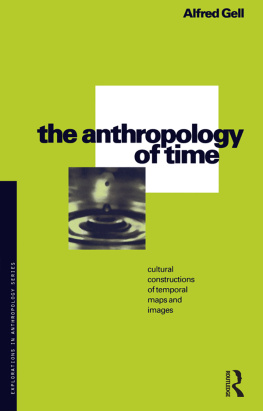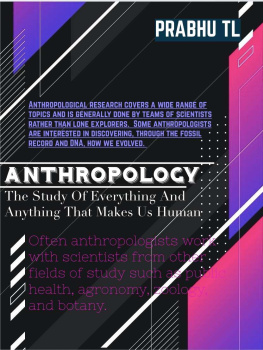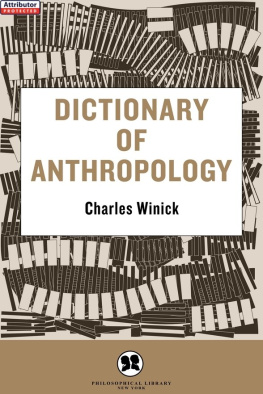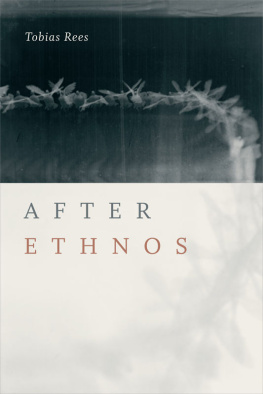Description &
Comparison
in Cultural
Anthropology
First published 1970 by Transaction Publishers
Published 2017 by Routledge
2 Park Square, Milton Park, Abingdon, Oxon OX14 4RN
711 Third Avenue, New York, NY 10017, USA
Routledge is an imprint of the Taylor & Francis Group, an informa business
Copyright 1970 by Ward H. Goodenough.
All rights reserved. No part of this book may be reprinted or reproduced or utilised in any form or by any electronic, mechanical, or other means, now known or hereafter invented, including photocopying and recording, or in any information storage or retrieval system, without permission in writing from the publishers.
Notice:
Product or corporate names may be trademarks or registered trademarks, and are used only for identification and explanation without intent to infringe.
Library of Congress Catalog Number: 2006045613
Library of Congress Cataloging-in-Publication Data
Goodenough, Ward Hunt.
Description and comparison in cultural anthropology / Ward H. Goodenough.
p. cm.
Originally published: Chicago : Aldine Pub. Co., 1970, in series: The Lewis
Henry Morgan lectures ; 1968.Includes bibliographical references and index.
ISBN 0-202-30861-8 (alk. paper)
1. EthnologyMethodology. I. Title.
GN345.G6 2006
306.01dc22
2006045613
ISBN 13: 978-0-202-30861-6 (pbk)
F or R uth
Contents
THE LEWIS HENRY MORGAN LECTURES are intended to commemorate both the man and his work, the latter being viewed as having provided an admirably broad and substantial base for anthropologists of later generations to build upon, as they have done and continue to do in diverse ways.
Professor Goodenoughs work, in the past and in this book particularly, emphasizes the vitality and fruitfulness of Morgans contributions. Not only do these Lectures carry forward Morgans interests in kinship; they reflect as well his concern for comparative studies undertaken with the aim of ultimately understanding mankind.
Moreover, Professor Goodenough has elucidated recent developments in the collection, analysis, and presentation of cultural data in ways that make it easier for all of us to see how his methods (in themselves specialized) can broaden and deepen our understanding of culture and of man.
Morgan, himself a pioneer in method, would surely have been an attentive auditorand discussantat Professor Goodenoughs Lectures, and in his seminars and the less formal events in which he participated while at Rochester, and to which he contributed so much. Those faculty and students who were privileged to hear him on these occasions can testify not only to the interest stimulated by Professor Goodenoughs presentations, but to his generous responsiveness in the give and take of discussion.
This volume is an expanded version of the Lewis Henry Morgan Lectures delivered at the University of Rochester, April 2 to 11, 1968.
Alfred Harris
Department of Anthropology
University of Rochester
In Forewords to earlier volumes of this series, most recently in Professor Meyer Fortes Kinship and the Social Order (1969), there are brief paragraphs about Lewis Henry Morgans connection with the University of Rochester and about the initiation of the Morgan Lectures in 1963. Interested readers can refer to previous volumes for these notes, which need not be repeated here.
THE OCCASION for this little book was a series of four Lewis Henry Morgan Lectures at the University of Rochester during two weeks in April 1968. In the year and a half since, I have expanded and revised the text prepared for the first three lectures and have newly written the fourth, originally delivered from notes. I have been able to take account of some of the literature that has appeared in the interim, and I have taken advantage of seminar discussions with students and faculty at the University of Rochester.
The third lecture draws heavily on work in componential analysis sponsored by a research grant from the National Institute of Mental Health (Grant No. MH-06126). The other lectures are largely distillations from courses I have taught in social organization, and they owe much to the searching questions of students.
My debt to Professor George P. Murdock is obviously great. I was his student when he was writing his landmark work Social Structure. It has served as a point of departure in the development of my own thinking about the matters I discuss here. And it was as his student that I first began to formulate in my doctoral dissertation the point of view I present in the fourth lecture.
Finally, I must thank Alfred and Grace Harris, along with their colleagues and students at the University of Rochester, for a most enjoyable and stimulating experience.
Introduction
H UMAN SOCIETIES , anthropologists maintain, despite their many forms and diverse customs, are all alike in being expressions of mankinds common human nature. Anthropology, of course, aims to clarify just what that nature is. The self-examination this search requires is not easy. Our theories are almost inevitably colored by the image we would like to have of ourselves, not only as men in contrast with animals, but as particular men in contrast with other men. The history of anthropology has been a continual struggle to get beyond the ethnocentric assumptions by which we pride ourselves as civilized, Christian, and so on, and to see human phenomena other than through the lenses to which our societys customs have habituated us.
The study of social organization has just such a history. The topics discussed in this book have commanded more attention from anthropologists since the days of Bachofen, McLennan, Maine, Morgan, and Westermarck than most other topics one is likely to name. Yet anthropologists are still arguing over fundamental concepts and are still engaged in the search for definitions they can apply to all societies. Indeed, every one of the things I shall discuss marriage, family, descent, and kinshipposes a conceptual problem.
It does so because all along we have been taking for granted that we know what these things are. They are all phenomena that we recognize in our own society without difficulty most of the time, and we can talk with one another meaningfully about them. But when we go to other societies, these familiar concepts begin to be troublesome. It is difficult to decide what is marriage among the Nayar of southwestern India and what is kinship among the Trobriand Islanders.
But we have to find some set of terms that will enable us to describe other cultures with minimal distortion from ethnocentric cultural bias. And we need some set of universally applicable concepts that will enable us to compare cultures and arrive at valid generalizations about them. Fifteen years ago, Kluckhohn (1953: 521) spoke of this need, saying:
Valid cross-cultural comparison could best proceed from the invariant points of reference supplied by the biological, psychological and sociosituational givens of human life. These and their interrelations determine the likenesses in the broad categories and general assumptions that pervade all cultures because the givens provide foci around which and within which the patterns of every culture crystallize. Hence comparison can escape from the bias of any distinct culture by taking as its frame of reference natural limits, conditions, clues, and pressures.



